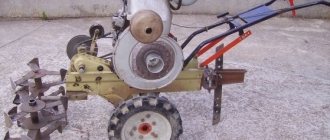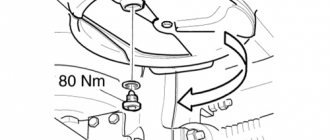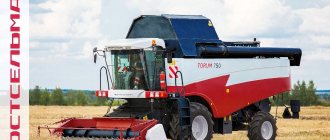Components of the cooling system of the D-245 diesel engine
Cooling system D-245 for ZIL-5301 Bychok, GAZ-3309, MAZ-4370 closed-type gear, with forced circulation of coolant from a centrifugal pump.
The engine cooling system as part of a vehicle must ensure that the temperature of the coolant leaving the diesel engine is no more than plus 100°C and the oil temperature is no more than plus 115°C at an ambient temperature of plus 40°C.
The D-245 water pump is driven by a V-belt from the crankshaft pulley. Litol lubricant was placed in the bearing cavity of the pump during assembly. During operation, bearings do not need to be lubricated.
The temperature of the liquid in the cooling system is monitored using a remote thermometer, the sensor of which is installed in the cylinder head. In addition, a light sensor for emergency coolant temperature is installed in the thermostat housing cover.
It is prohibited to operate a diesel engine when the warning light for emergency coolant temperature in the cooling system comes on.
The temperature of the coolant in the D-245 cooling system must be maintained within the range from 85º C to 95º C. To accelerate the warm-up of the diesel engine after start-up and automatically regulate the temperature regime at various loads and ambient temperatures, a thermostat with a temperature at which the main valve begins to open is 87 ± 2 ° WITH.
There are two options for installing a fan on a diesel engine: without a spacer and with a spacer. It is possible to install a fan with an electromagnetic or viscous fan shut-off clutch.
Fig. 1a - Diagram of the D-245 diesel cooling system. (ZhMT)
1- water pump; 2 — thermostat; 3 – water pump drive belt; 4 – fan; 5 – cylinder head cooling jacket; 6 – cylinder block cooling jacket; 7 – cylinder block liner; 8 – taps for draining coolant; 9 – pipe; 10 – filler plug; 11 – light indicator for emergency coolant temperature; 12 coolant temperature indicator; 13 – radiator; 14 – oil filter; 15 – liquid-oil heat exchanger (LHT); 16 – plug for draining the coolant; 17 – pipe for draining coolant from liquid solids; 18 – pipe for supplying coolant to liquid coolant.
Fig. 1b – Diagram of the cooling system of the D-245 internal combustion engine. (without LMT)
1- water pump; 2 — thermostat; 3 – water pump drive belt; 4 – fan; 5 – cylinder head cooling jacket; 6 – cylinder block cooling jacket; 7 – cylinder block liner; 8 – taps for draining coolant; 9 – pipe; 10 – filler plug; 11 – light indicator for emergency coolant temperature; 12 coolant temperature indicator; 13 – radiator.
Maintenance of the D-245 diesel cooling system
Check the coolant level of the D-245 engine every shift before starting the diesel engine. Remove the radiator cap and check the coolant level, which should be up to the top of the filler neck. Do not allow the level to drop below 40 mm from the top of the filler neck.
Maintenance and flushing of the cooling system
Fill the cooling system with low-freezing coolant. Monitor the coolant temperature; normal operating temperature should be 85-95°C. If the temperature rises above normal, check the coolant level in the radiator, radiator leaks, and fan belt tension.
If necessary, but at least every 120 thousand km of the vehicle, flush the cooling system to remove contaminants. For rinsing, use a solution of 50-60 g of soda ash per 1 liter of water.
Flush the D-245 internal combustion engine system in the following order:
— pour 2 liters of kerosene into the radiator and fill the system with the prepared solution; — start the diesel engine and operate for 8-10 hours or 350-400 km, then drain the solution and rinse the cooling system with clean water.
Disassembly and assembly of the water pump (pump) of diesel engine D-245
Unscrew nut 9 (Fig. 2) securing the water pump drive pulley. Using a puller, remove pulley 7 of the water pump. Remove ring 12 from the pump housing, which locks the bearing assembly. Remove impeller 3 from pump shaft 2 using the threaded hole in the end of the impeller (M18×1.5) using a special bolt.
Press the shaft with bearings out of the water pump housing. The direction of pressing out is towards the installation of the pulley. Press the bearings off the shaft. Remove the thrust ring. Press the oil seal out of the pump housing. Defect the parts.
Fig. 2 – Water pump (pump) of the D-245 engine
1 – body; 2 – pump roller; 3 – impeller; 4 – water pump seal; 5 – bearing; 6 – bushing; 7 – pulley; 8 – key; 9 – nut; 10 – plug; 11 – washer; 12 – retaining ring; 13 – thrust ring.
Install thrust ring 13 on the pump shaft and press on the bearings. Fill the bearings and bearing cavity with 45 g of grease. Press the shaft with bearings into the pump housing. Install ring 12 that locks the bearing assembly. Install the pump pulley, washer and nut. Tighten the nut, ensuring a torque value of 120…140 Nm.
Using a mandrel, press the seal of the water pump D-245 of the ZIL-5301 Bychok, GAZ-3309, MAZ-4370 gear with the inner housing onto the water pump shaft and, at the same time, press the outer seal housing into the water pump housing until the flange of the seal housing stops against the mating surface of the housing pump
In this case, the design of the mandrel must ensure that the inner seal casing is pressed in such a way that the end surface of the inner casing is located at a distance of 11.2 ± 0.2 mm from the mating surface of the pump casing.
Press the impeller onto the shaft, install the plug into the end of the impeller. The sinking of the end of the impeller relative to the mating plane of the water pump housing should not exceed 0.3 mm; protrusion of the impeller is not allowed. Install the water pump on the diesel.
Checking the tension of the D-245 engine fan belt
Read also: Work on transporting cars from Finland
Carry out the check every 5 thousand km. The tension of the engine fan belt is considered normal if its deflection on the crankshaft pulley - generator pulley branch, in accordance with Figure 30, is within the range of 12-17 mm when the belt is pressed with a force of 40 N.
To adjust the engine belt tension, loosen the generator mount. Adjust the belt tension by turning the generator housing. Tighten the bolt securing the bracket and the nuts of the generator mounting bolts.
The diagram of a diesel liquid cooling system with forced circulation of coolant from a centrifugal pump is shown in Figure 1.
The coolant temperature in the system is controlled by a temperature gauge, the sensor of which is installed in the rear of the cylinder head.
In addition, an emergency coolant overheating sensor is installed in the liquid pump housing
On cars of the latest series of construction, instead of a liquid level control valve, a coolant level monitoring sensor 5 is installed in the expansion tank.
It is prohibited to operate a diesel engine when the coolant overheating warning light comes on.
The temperature of the coolant in the cooling system must be maintained within 75°-95°C.
When opening the expansion tank cap when the engine overheats, you should remember that steam may escape from the neck of the tank, leading to burns to your face and hands.
To speed up the warm-up of the diesel engine after start-up and automatically regulate the temperature regime at various loads and ambient temperatures, a thermostat with a solid filler is used.
The liquid pump, fan and generator are driven from the diesel crankshaft pulley using two V-belts.
Litol-24 lubricant is placed in the bearing cavity of the pump housing when the pump is assembled at the manufacturer and does not require replenishment during the entire period of operation of the diesel engine.
The lubricant is replaced only after disassembling the liquid pump.
Checking the tightness of the diesel cooling system and the condition of the radiator cap valves using the DSO-2 indicator (Fig. 2).
A float is placed in the body of the device, with the help of which the moment of operation of the valves of the expansion tank plug, adjusted to a certain pressure, is recorded.
When valves 3 and 13 are closed, pressure is created in the air cylinder. Using a gearbox, it is set to 0.15...0.16 MPa.
The plug removed from the neck of the expansion tank is secured to glass 5. When tap 8 is closed, air is supplied to the upper cavity of the glass.
The lower cavity of the glass is connected to the indicator using tap 8. The pressure acting on the steam valve is recorded by a pressure gauge at the moment the float in the indicator rises.
Then the indicator is connected to the lower cavity of the glass, and air is supplied from the air cylinder to the upper cavity and the pressure at which the air valve of the stopper opens is recorded.
To check the tightness of the cooling system using the DSO-2 device, you need to install the device nozzle connected to tap 3 on the neck of the expansion tank instead of the plug.
With valves 3 and 13 closed, the reducer creates a pressure of 0.6...0.7 MPa and opens valve 3.
The change in pressure in the cooling system is monitored using a stopwatch and pressure gauge.
Simultaneously with checking the tightness of the system, you can check the condition of the cylinder head gasket on a running diesel engine.
For this check, set the minimum crankshaft speed and observe the pressure gauge readings.
The oscillation of the pressure gauge needle indicates the flow of gases from the cylinders into the cooling system, i.e. about damage to the gasket or the cylinder head itself.
The Minsk Automobile Plant began production of MAZ-4370 trucks in 1999. In 2003, the car was recognized as the best in its class. This model received the nickname “Zubrenok”. The German MAN L 2000 was taken as the basis for the development of the truck (the carrying capacity of the Minsk product is twice as large). Initially, the MAZ-4370 was equipped with exclusively foreign cab and chassis. However, later its own chassis was created. The 5-ton truck differs from its analogues in having a low body frame, which makes unloading and loading easier. The model is intended for regional, suburban and urban transportation.
Truck production
MAZ-4370 or “Zubrenok” is produced by Belarusian. The company traces its history back to 1944, when a car restoration and repair workshop was created in liberated Minsk. Gradually, the company switched to assembling trucks from vehicle kits. In 1945, construction began on the production workshops of the plant for the production of heavy-duty vehicles. The company assembled the first MAZ-205 trucks in 1947, and two years later conveyor production of cars was established. An important moment in the development of the plant was the development and production of trucks with a cabover configuration. Subsequently, thanks to its own developments, the company not only expanded its range of cars, but also significantly increased its production volume.
Currently, the MAZ association produces more than 80 modifications of trucks for various purposes, and also produces buses, trolleybuses, trailers and semi-trailers.
Electrical equipment
Suspicion fell on a mechanical malfunction during the synchronization of the camshaft and crankshaft sensors count 48, setting the ignition marks, the integrity of the resistance coils of the crankshaft and camshaft sensors, the required fuel pressure, and, accordingly, with the working pump of the fuel injection pump and low pressure pump, but at the same time the car had a USR valve. In order for this special vehicle to serve for a long time and never let its owners down, it must be promptly carried out through the diagnostic procedure and all detected problems must be repaired.
History of the truck
The appearance of the MAZ-4370 is associated with the increased demand for medium-duty vehicles at the end of the 20th century, as well as the desire to expand the production line of trucks through the new model. Such a compact vehicle can be effectively used in urban environments and on short commuter routes to transport small quantities of various cargoes.
In order to speed up the development and start of production at the enterprise, a truck of a similar class MAN-L-2000 was chosen as a prototype, but the load capacity of this model was only 2.5 tons. The lower load capacity was not considered a problem. Due to the developed main elements of the new truck, frame, suspension, axles, she not only designed the truck in a fairly quick time, but also carried out all the required testing and certification work. This made it possible to begin production of the MAZ-4370 Zubrenok model in 1999.
Why did it happen so?
Perhaps the automatic requests do not belong to you, but to another user accessing the network from the same IP address as you. You need to enter the characters into the form once, after which we will remember you and be able to distinguish you from other users exiting from this IP. In this case, the page with the captcha will not bother you for quite a long time.
You may have add-ons installed in your browser that can make automatic search requests. In this case, we recommend that you disable them.
It is also possible that your computer is infected with a virus program that is using it to collect information. Maybe you should check your system for viruses.
If you have any problems or would like our support team, please use the feedback form.
MAZ Zubrenok is a vehicle designed to transport various cargoes. Produced by the Minsk Automobile Plant.
Model design
Unlike produced Russian medium-duty vehicles, the Belarusian new product received the traditional MAZ hoodless layout. This significantly increased the size of the vehicle’s side platform, and in terms of this indicator, only the KAMAZ-4308, released in 2007, could compete with the MAZ-4370 (among CIS trucks).
The next distinctive feature of the Zubrenok was a high, comfortable cabin designed for 3 people. In order to improve aerodynamics, it was equipped with three spoilers and a fairing.
The design of the car is based on a durable ladder-type frame with two channel-shaped spars, as well as cross members that have a round tubular and U-shaped section. Thanks to the dependent type of front and rear suspension on semi-elliptical springs in combination with 17.5-inch wheels, the truck received a low platform, which, according to reviews from MAZ-4370 owners, was very comfortable when performing loading and unloading operations.
At the initial stage of production, the car was equipped with an MMZ D-245.9-540 engine with a power of 135 horsepower and a five-speed manual transmission. Subsequently, the number of power units on the MAZ-4370 increased.
Device
MAZ 4370 received a front dependent leaf spring suspension with hydraulic shock absorbers (telescopic type) with a stabilizer. An I-beam was used as the front axle. The rear suspension was built on longitudinal semi-elliptic springs. This design has proven itself well and is characterized by increased stability. The MAZ 4370 had a front-wheel drive, rear-engine layout with a 4 by 2 wheel arrangement. For the first models, foreign chassis produced at the MAN plant were used. Later, the Minsk Automobile Plant began producing its own chassis. The MAZ 4370 was equipped with a low-frame body, which was its main advantage. This arrangement made it possible to transport large cargo at great heights without obtaining additional permits. The car's suspension turned out to be slightly harsh due to the use of standard springs, which are stacked sheets of metal. Its main advantage was the simplicity of the device. The service life of the springs reached 100-200 thousand km. At the same time, the rigidity decreased noticeably with a decrease in tire pressure or after loading the vehicle.
The car was equipped with 2 types of transmissions:
- 5-speed manual transmission SAAZ-3206 (manufacturer – Russia, Saransk Aggregate Plant). This gearbox is characterized by small gear ratios and high rigidity.
- 5-speed manual gearbox ZF S5-42 (assembled in Spain or China). Gear shifting is performed without sharp clicks and more smoothly.
Torque was transmitted to the transmission elements from the engine via a single-plate dry friction clutch. An interwheel differential with locking was provided for the rear axle.
The design of the MAZ 4370 used a drum-type brake system, which included 2 main elements - a drum and brake pads (some versions received front disc brakes). This mechanism was both simple and reliable. The braking system was driven by a pneumohydraulic system, the action was carried out on all wheels. The car again had a parking brake driven by energy accumulators. The car was equipped with 17.5-inch tires (235/75R) with a specialized tread. Initially, the model was equipped with Continental tires, since tires of the required size were not produced in the CIS countries. Later, the Minsk Automobile Plant began to cooperate with the Yaroslavl plant, which began supplying the partner with Y478 tires. They were installed in the stock version.
MAZ 4370 received a modern power supply system with a voltage of 24 V. The power sources were 2 6-ST-110 batteries and a generator 3232.3771.10. The engine was started with an ST-230R starter.
The car was equipped with a 2- or 3-seater operator's cabin, which could be equipped with a sleeping place, allowing the driver to rest if necessary. This place was folding and, if necessary, was retracted into the back wall. An electronically controlled heater was again installed in the operator’s cabin, which ensured optimal temperature conditions in winter. The doors had special handrails that made it easy to climb inside. The operator's cabin itself could hardly be called modern, but in terms of convenience it was considered one of the best.
An awning or other equipment was installed on the MAZ 4370 frame. The truck is currently offered in the following versions:
- truck crane;
- manipulator;
- concrete mixer;
- closed body;
- refrigerator.
Technical specifications
The main technical characteristics of the MAZ-4370 are as follows:
- engine model - MMZ D-245.9.540;
- type – diesel turbocharged;
- volume - 4.75 l;
- number of cylinders/location – 4/L-line;
- power – 136.0 l. With.;
- execution - Euro 2;
- drive – rear;
- wheel formula - 4×2;
- gearbox type – five-speed manual;
- maximum speed – 90.0 km/h;
- fuel consumption (combined cycle) – 18.1 l/100 km;
- wheelbase – 3.0 m;
- length – 6.20 m;
- height – 0.54 m;
- width – 2.49 m;
- platform design - onboard, with the possibility of installing an awning;
- load capacity – 4.95 t;
- total weight - 10.10 tons;
- front axle load – 3.65 t;
- rear axle load – 6.40 t;
- tire size - 8.25R20, 235/75R17.5
- fuel tank volume – 130 l;
- On-board voltage is 24 V.
Zubrenok engines
In addition to the MMZ D-245.9.540 diesel engine, the MAZ-4370 truck is equipped with the following power units:
1. Model - D-245.30E2
- type - supercharged diesel;
- cooling – liquid;
- number of cylinders – 4;
- cylinder arrangement – in-line (L);
- volume – 4.75 l;
- power - 156.4 liters. With.;
- compression index – 17.0;
- weight – 0.50 t;
- environmental performance – Euro-2.
2. Model - D-245.30E3
- type - supercharged diesel;
- cooling – liquid;
- number of cylinders – 4;
- cylinder arrangement – in-line (L);
- volume – 4.75 l;
- power - 156.4 liters. With.;
- compression index – 17.0;
- weight – 0.45 t;
- environmental performance – Euro-3.
3. Model - DEUTZ BF4M 1013FC
- type – diesel;
- cooling – liquid;
- number of cylinders – 4;
- cylinder arrangement – in-line (L);
- working volume – 4.80 l;
- power - 170.0 l. With.;
- compression index – 16.1;
- weight – 0.56 t;
- environmental performance – Euro-3.
Paired with the DEUTZ engine is a five-speed ZF S5-42 gearbox.
Comfortable cabin
A number of models have spacious cabins of improved comfort with a folding place for sleeping and resting, which is convenient when performing long routes. There are 3 seats available. The machine is successfully used in winter thanks to the installed heating system. The low position allows you to climb into the cabin without much effort. For the convenience of the driver and passengers, handrails are installed.
Salon MAZ 4370
Car modifications
In addition to various power units, the car has wheelbases of several lengths:
- 3.30 m;
- 3.35 m;
- 3.70 m;
- 4.20 m.
This number of options definitely serves as additional popularity for the truck. In addition to the standard cab, a double cab with a berth is available.
in combination with a variety of engines and different wheelbases produces the following modifications:
- onboard;
- side tilt;
- dump truck;
- van;
- isothermal van;
- chassis;
- tow truck;
- onboard with CMU.
A significant number of modifications, wheelbase options and cab designs have significantly expanded the scope of application of the MAZ-4307.
Maintenance and possible problems
To maintain the good condition and high-quality operational parameters of any vehicle, including the characteristics of the MAZ-4370, it is required to perform maintenance in accordance with the manufacturer’s regulations. The following types of required maintenance are established for the Zubrenok truck:
- daily - before and after work;
- break-in - performed after 1.0 thousand mileage;
- TO-1 – 5.0 thousand km;
- TO-2 – 20.0 thousand km;
- seasonal - when the operating season changes.
Depending on the operating conditions of the truck, the mileage between the first and second service may have been reduced.
Among the possible problems, especially in the initial period of vehicle operation, it should be noted:
- difficult gear shifting due to poor clutch adjustment;
- increased heating of the rear axle due to inaccurate adjustment of the engagement gears, as well as an excessive amount of oil in the crankcase;
- uneven power steering operation due to the presence of air;
- the vehicle drifts when moving in a straight line, due to loosening of the spring ladders;
- low pressure in the brake system due to a leak;
- Slipping of the generator tension belt.
Advantages and disadvantages of the car
Owners in their reviews of the MAZ-4370 highlight the following main advantages of the truck:
- affordable price;
- comfortable cabin;
- traction parameters of engines;
- economical operation;
- low loading height;
- large platform area;
- compact sizes.
Among the disadvantages most often noted:
- low heater power;
- frequent breakdowns of the rear axle gearbox;
- gearbox defects;
- rapid wear of the clutch disc;
- spring failures.
Despite the presence of shortcomings, especially at the initial stage of production, due to its carrying capacity, cost and the availability of a large number of different modifications, the MAZ-4370 medium-tonnage truck is in stable demand. The improvements and modernizations carried out allow the Zubrenok to remain the most popular truck in its segment.
Distant relative: MAZ-MAN on the eve of the 20th anniversary of the brand
At the last of them, Comtrans-2004, the MAZ-MAN-750268 dump truck with an 8x4 wheel arrangement took two prizes for originality of design and for the best off-road vehicle. In the 2010s, the turn of a new generation of medium-duty trucks came, Minsk Auto was spared many of the shortcomings of the first model; equipped with a new restyled cabin and more modern and environmentally friendly diesel engines.











